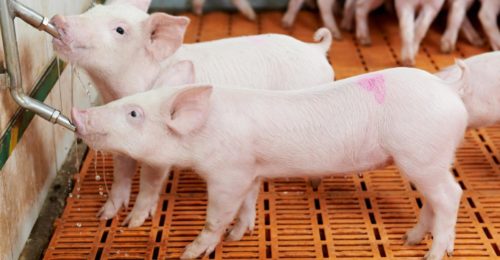Don’t Forget About the Water!
Posted: May 27, 2020 | Written By: Dr. Mark Whitney, Swine Nutrition and Production Specialist

Although water is by far the most consumed nutrient in pork production, it almost always gets the least amount of attention. Issues relating to water can have significant, usually negative effects on animal performance and health. To avoid these impacts, check water quantity and quality on a regular basis and correct deficiencies. This is especially important with summer and increased temperatures right around the corner! Becoming proficient at identifying, troubleshooting, and treating water issues is paramount to good animal husbandry, pig welfare, and overall production performance.
How much water is sufficient for pigs? The correct answer is: it depends. The stage of production and size of the animal will have significant impacts on the water quantity needed.
When pigs are first born, their bodies comprise of about 70% water. Mature market pigs’ bodies have less by comparison; about 55% of their body weight is water. Much of this difference is due to the fact that lean muscle is approximately 75% water, while fat tissue only contains 20% water.
Water quantity adjustments will need to occur in each growing stage. Nursery pigs should have a flow rate from water cups or nipples of 1 cup/minute, with no more than 10 pigs per waterer. Finishing pigs and breeding animals should be receiving 4 cups/minute from nipples or water cups, with 12 – 15 pigs per waterer in ideal conditions. Check flow rates in all pens using a measuring cup and stopwatch to ensure all waterers are functioning correctly and water delivery is adequate.
Many other factors can impact how much water pigs need. The following list outlines some factors affecting water quantity:
- Ambient temperature: Pigs require more water during hot summer temperatures. Additionally, they will change feed and water intake patterns to minimize excess metabolic heat production during the heat of the day by eating during the cooler periods of the day.
- Diet: When diets contain increased crude protein and/or salt content, pigs will consume more water. Their bodies require the additional water to deaminate, or break down, and dispose of excess amino acids or to maintain fluid equilibrium by removing extra salt.
- Housing: Increased pen density or competition at waterers will minimize the capability of pigs to increase water intake as needed.
- Disease status: Pigs that are exhibiting diarrhea due to disease challenge will require much greater levels of water and electrolytes to maintain water equilibrium. At the same time, their desire to consume adequate levels of water will often decrease.
- Flow rate: Having a water flow rate that is less than optimal will very likely limit the pigs’ ability to properly consume adequate levels of water. Conversely, especially with young pigs, if flow rate is too high, water consumption could also be reduced if the waterer sprays pigs, frightening them.
- Water temperature: During hot weather, providing cool water will increase water consumption in pigs.
- Productivity: Lactating sows are supporting much larger litters and, thus, producing much more milk than in years past. To keep up with milk production, sow water consumption is greater and of even more importance. Sows cannot produce adequate levels of milk for their offspring without adequate water intake. Lactating sows will consume 5 – 7 gallons of water each day, with a target of 4 – 8 cups/minute for flow rate out of a cup or nipple waterer.
If you have questions about optimizing your pigs performance by managing their water intakes, please reach out to one of our Swine Nutrition and Production Specialists. You can also learn about all of Form-A-Feed’s swine services. We specialize in providing customized solutions to your operation!